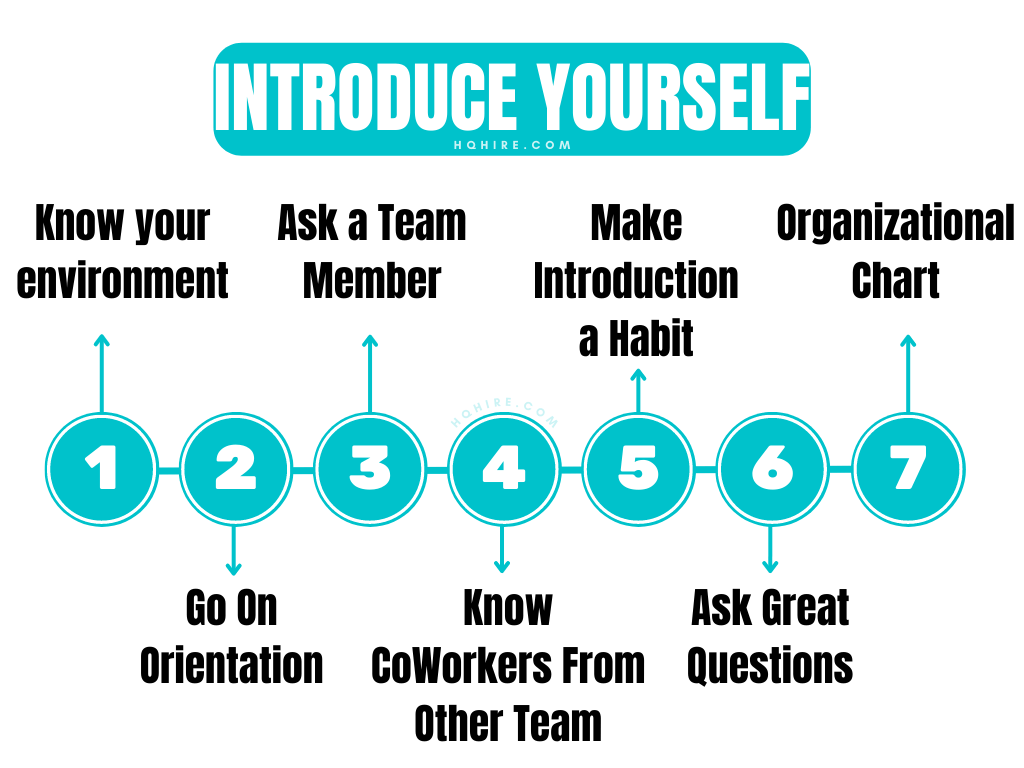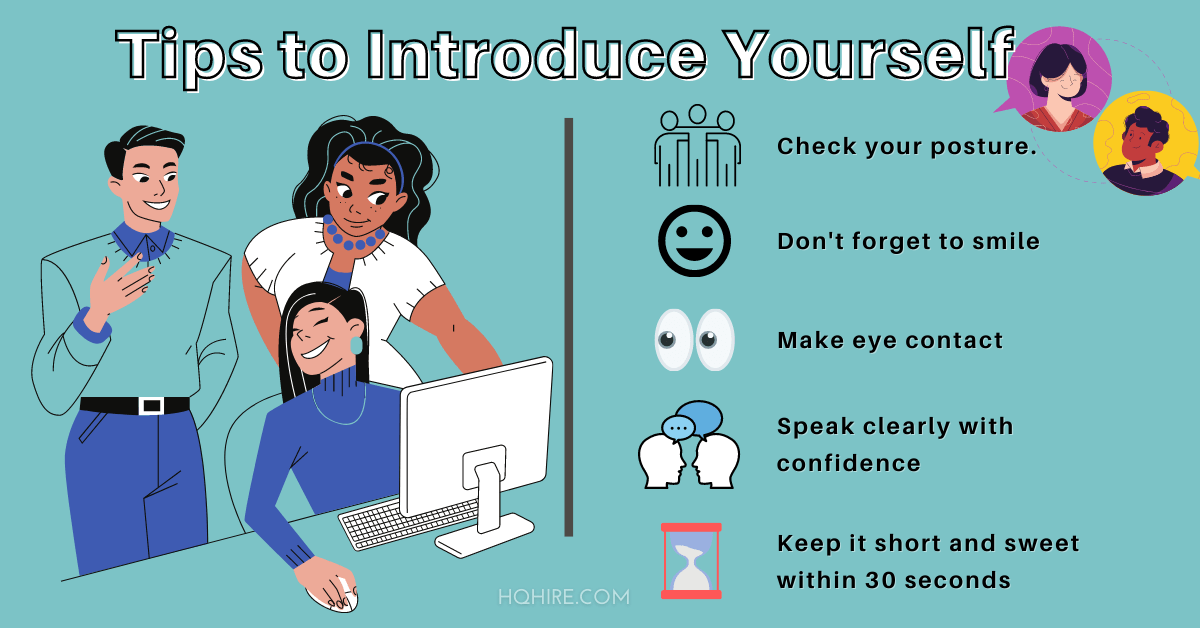Today’s your first day at work? Trying to introduce yourself on your first day or week at a new workplace can be quite scary because you are not sure what your new colleague will be like.
You will be asking questions like, “Are they easy-going?” or “Will they accept me?“
However, it doesn’t matter if the company has 5 employees, or 5,000 employees, making a great first impression counts. Your first impression starting from what you wear to work, the color of your outfit, things you bring, to the things you say and tone you use during conversation.
Key Takeaways
- Knowing how to professionally introduce yourself can help you create the right first impression that can help you in your future career success.
- How you introduce yourself depend on the environment and the type of coworkers you have.
- Getting your coworkers or team members to help you make your first introduction is the best way to get acquainted with new colleagues.
- Be proactive to make introduction a habit, ask power question and get to know other during your orientation or any other opportunities.
- The organization chart is a great tool to help you in getting to know the right people at work.
How To Introduce Yourself On The First Day Of Work?
A great introduction to your new colleague can be difficult.
But fortunately, you will get a little help from your supervisor, or human resource department who will help to introduce you to your coworkers.
What’s left, is totally up to you.
Starting off your new job well will help you in building both professional and personal relationships with your coworkers.
Knowing how to properly introduce yourself in person or through email is the first step in building a great working relationship with your co-workers at work.

1. Know Your Environment
There are generally 2 ways to introduce yourself:
- Casual Introduction
- Formal Introduction
When you are in a new environment, it is important for you to “fit in”.
First, get a rough idea of the environment in your new workplace.
Next, consider your new workplace’s environment before determining if you should introduce yourself in a formal or casual way.
And always remember, your dress code and the colors of your outfit plays a big part as well!
Career experts advise new employees should prepare for their new job by checking with the human resource about the company’s culture before they come to work.
“As an new employee, you need to learn the company culture before anything else.”
A.C.
A company’s culture lets you learn more about the company’s expectations and the way the people interact in the company:
- Clan Culture. Clan culture is often referred to as a collaborative culture, this culture is focused on teamwork and coherence between coworkers.
- Adhocracy Culture. Adhocracy culture is often focused on the ability to adapt quickly to changing conditions and it is big on innovation and has a higher acceptance of risk-taking.
- Market Culture. Market culture is focused on the ability to remain competitive in a high-stress, fast-paced environment where the bottom line is the main priority.
- Hierarchy Culture. Hierarchy Culture is focused on long-term stability, and consistency, and emphasizes on share set of values throughout the organization.
The company’s culture gives you an idea of the leadership style of the top management team, which helps you in deciding the most appropriate form of introduction to your fellow coworkers.
Think up a simple introduction that you can use to introduce yourself to your co-workers. Your introduction will include your name and job title.
Starter
“Hi, John here. I am the new Marketing manager.”
Example – General
In a simple introduction, you will be expected to talk more about yourself when you and your team are in a more relaxed setting. You can talk about your career, interests, or even hobbies.
“Nice to meet you. My name is Jesse. I am the new accounts analyst. I worked at ABC Company for one year before joining this company. Outside of work, I enjoy doing yoga and reading novels at the beach.”
Example – People Leaders
The way you introduce yourself depends on your role in the company and the people you are addressing. As a people leader, a proper introduction to your new team can help you gain your team members’ respect. This will help to establish yourself as a leader and not just a boss.
Thus, in these cases, you may find it better to give a longer introduction.
“Hi team, my name is Peter Thomas, your new marketing manager. Previously I worked as a marketing manager in ABC Company and have 15 years of experience marketing a wide array of events, from conferences to international sports events. I believe I can lead this team to even more success. However, I cannot produce great marketing results alone. This is why I need your utmost commitment and cooperation. Together, we can achieve great things. Marketing is a team effort. And I am excited to work with all of you.”
2. Orientation
Most big companies and even some smaller companies or remote teams will have orientation programs that help new employees to settle into the company. Orientation is basically one of the best times to introduce yourself to your peers, who might just be as lost as you.
Pro Tip: When a group of new colleagues gathers together, this may just be the best opportunity to make friends with colleagues from different departments.
If you are one of the lucky few where your company has an orientation program, remember to take the opportunity to introduce yourself to as many colleagues as possible.
Knowing someone in the company can help you calm your nerves and feel more comfortable adapting to the company.
Knowing what emails you’ll need to send when you start a new job can help you integrate into the company faster and easier.
Often, your manager or a senior colleague will be helping to show you around the company and help you with the introductions.
They will introduce you to your team members, colleagues from the same department, and sometimes even colleagues which are from other departments that you will be interacting with often.
Example – Simple and Quick Introduction
“Hi, I am Jeff from the Marketing Team. This is my first day with the company, it is great to meet you.”
3. Ask a Team-member to Help Introduce You
On your first day of work, the few first people you will meet will probably be your team members. These people are some of the co-workers that you will probably work most frequently with.
If in any case that the person who helps you during the orientation does not introduce you to the team (this does happen sometimes). Probably you may want to take the initiative to ask for an opportunity to meet your team members.
Not only it is important for you to get to know your team early. It is good to let them know that you are keen to get to know everyone on your team and that you are excited to be a part of the team.
Example – Ask to Get Introduced
“I am excited to have met a few people this morning, but I will really want to get to know the people I will be working with. Do you think we can go meet my team members?”
Pro Tip: In a team, there are usually more than just a few people. Take the initiative to introduce yourself to your team members one by one. This will help you to build rapport with each of them and make it much easier for you to talk with them in the future.
Example – Simple Introduction to Your Team Members
“I’m Mike, the new engineer. Nice to meet you. We will be working together in the future and I am excited to be a part of the team.”
4. Know Co-Workers from Other Teams
In many companies, you will be working on projects with co-workers from other teams or departments. Introduce yourself to these colleagues who are outside of your own team. Getting to know each other early can help you to create a positive working relationship early for both you and your colleagues. This may even help your team to work more efficiently.
Talk to your colleagues and find out which other colleagues you will be collaborating with for your new role.
Do a simple introduction to them and show them that you are excited to work with them in the future. This can be made easier if your seniors can help you to introduce yourself to them, otherwise, just take the initiative and make the introduction yourself.
Even if you are an introvert, just start a self-introduction with a simple email, which you can find some of the best examples here.
Example – Introduction to Co-Workers of Other Department
“Good morning. I am Sam, a new production engineer from the manufacturing department at the 2nd floor. I am looking forward to working with you in the future. See you around.”
5. Make Introduction a Habit
Most first introductions are made during the orientation on your first day of work. You will probably meet your team members and people whom you will work closely with in the future. But it is just as important to get yourself introduced to more people in the company, those whom you will see each day.
Finding opportunities for introduction to your other co-workers enables you to make more new acquaintances and friends in your company. This helps to let you settle in faster and feel more comfortable in the new environment.
You may want to set goals to get to know more people using goal-setting techniques, this will help you to develop a habit of wanting to know everyone in the company.
If you are working remotely, you can set up a virtual meeting to introduce yourself to your coworkers as well.
There are many other situations where an introduction can be made:
- Meeting
- Taking a Lift
- Coffee Break
Even if you do not get the chance to make introductions to someone during your orientation, you can introduce yourself to your coworkers in many other ways.
Example – Before Meeting
You can also casually introduce yourself to the people around you before the meeting start.
“Hi, my name is Sammy, I am the new account manager. Can you let me know what we will be discussing in this meeting?”
Example – At Meeting
Your manager may formally introduce you to the attendees. Usually, in this case, just keep it as brief as possible, so the meeting may proceed.
“Hi, my name is Grace. I’m the new copywriter in the team. My pleasure to work with you.”
Example – At a Lift
Just keep it as brief as possible, basically, it is the same idea as an elevator pitch.
“Hi, my name is Rav. I am the new copywriter. I just saw your presentation at the meeting yesterday and it is really interesting. This is my first week with the company. It is my pleasure to work with you.”
6. Power of Question
Remember the time when someone keeps talking, and you just wish that you can leave the room? A conversation is a two-way interaction. Simply just ask your new coworkers some simple questions after your introductions can help create a two-way conversation and help to build a rapport with them.
This simple trick can lead to positive connections with your new colleagues and great relationships in the future.
What questions should you ask?
Remember, this is not an interview, so please do not ask them “Tell me about yourself” or “What are your strengths and weakness”.
Since this is your first few interactions with your new colleagues, it will typically be more appropriate to ask work-related questions.
Example – Questions to Ask Your Colleagues
- “Nice to meet you, Daniel. What are the projects you are working on now?”
- “That sounds amazing, John. Will we be working together in the future?”
- “Sam, it is great knowing you! So how is the working culture is like over here?”
7. Organizational Chart
Asking around helps you learn lots of new information. But sometimes, having a copy of your new company’s organizational chart can guide you to know co-workers you should get to know first.
Some big corporations have a welcome pack that will be given to the new employee during the orientation.
In the welcome pack, an organizational chart will often be included with the names of your leadership team, as well as a seating chart of your co-workers.
If you don’t find it anywhere, you can request it from your human resource department, they will probably provide a copy to you.
Organization charts can help you to identify where your fellow co-workers are seated in the office. Getting yourself introduced to those you will be working with in the future will help you in your work and advance your career.
Pro Tip: Ask a co-worker from your team to help you with the introduction, this will allow the introduction to be much smoother and easier.
Example – Introduction to Co-Workers of Other Departments
“Hi, are you Amanda? I am Cassy from the sales department, great to meet you. I heard we will be collaborating on some projects in the future.”

Complete Home Office Guide
Up Next… How not to be nervous on your first day of work?
Frequently Asked Questions (FAQs) on Introducing Yourself at Work
Join over 11,000+ achievers who are committed to achieving their career goals!







Probably one of the most useful page about first day of work! Thanks for the Tips!
Thanks for the tips!
Thank you so much for the tips. They are awesome
Thanks Patrick! Glad you’ve found them AWESOME! You’ve just made my day 🙂
Hey Yuki! Glad you love it!